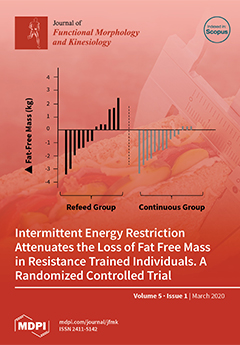There is a lack of research into how lean, resistance trained (RT) individuals respond to intermittent energy restricted diets. Therefore, we investigated body composition changes in RT-individuals during continuous energy restriction or intermittent restriction. A total of 27 males and females (25 ±
[...] Read more.
There is a lack of research into how lean, resistance trained (RT) individuals respond to intermittent energy restricted diets. Therefore, we investigated body composition changes in RT-individuals during continuous energy restriction or intermittent restriction. A total of 27 males and females (25 ± 6.1 years; 169 ± 9.4 cm; 80 ± 15.6 kg) were randomized to a ~25% caloric restricted diet Refeed (RF;
n = 13) or Continuous group (CN;
n = 14) in conjunction with 4-days/week resistance training for 7-weeks. RF implemented two consecutive days of elevated carbohydrate (CHO) intake, followed by 5-days of caloric restriction each week. CN adhered to a continuous 7-week caloric restriction. Body mass (BM), fat mass (FM), fat-free mass (FFM), dry fat-free mass (dFFM), and resting metabolic rate (RMR) were assessed pre/post-diet. Both groups significantly reduced BM (RF: baseline = 76.4 ± 15.6 kg, post-diet = 73.2 ± 13.8 kg, Δ3.2 kg; CN: baseline = 83.1 ± 15.4 kg, post-diet = 79.5 ± 15 kg, Δ3.6 kg) and FM (RF: baseline = 16.3 ± 4 kg, post-diet = 13.5 ± 3.6 kg, Δ2.8 kg; CN: baseline = 16.7 ± 4.5 kg, post-diet = 14.4 ± 4.9 kg, Δ2.3 kg) with no differences between groups. FFM (RF: baseline = 60.1 ± 13.8 kg, post-diet = 59.7 ± 13.0 kg, 0.4 kg; CN: baseline = 66.4 ± 15.2 kg, post-diet = 65.1 ± 15.2 kg, Δ1.3 kg
p = 0.006), dFFM (RF: baseline = 18.7 ± 5.0 kg, post-diet = 18.5 ± 4.5 kg, Δ0.2 kg; CN: baseline =21.9 ± 5.7 kg, post-diet = 20.0 ± 5.7 kg, Δ1.9 kg), and RMR (RF: baseline = 1703 ± 294, post-diet = 1665 ± 270, Δ38 kcals; CN: baseline = 1867 ± 342, post-diet = 1789 ± 409, Δ78 kcals) were better maintained in the RF group. A 2-day carbohydrate refeed preserves FFM, dryFFM, and RMR during energy restriction compared to continuous energy restriction in RT-individuals.
Full article






